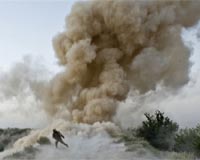| . |  |
. |
St. Louis (UPI) Jul 23, 2009 The first Boeing F/A-18F Super Hornet for the Royal Australian Air Force has had a test flight from Lambert International Airport in St. Louis as part of the manufacturer's preparations for the aircraft to make its maiden voyage to the buyer. Boeing unveiled the aircraft July 8 at the company's Integrated Defense Systems facility in St. Louis and the test flight took place on Tuesday, the company said. A Boeing test pilot was at the controls when the plane took to the skies and remained airborne for more than an hour. Boeing said it will complete delivery of the first of 24 F/A-18Fs to the RAAF later this month, three months ahead of schedule. The remaining 23 Super Hornets, each equipped with the Raytheon-built APG-79 Active Electronically Scanned Array radar, will be delivered to the RAAF between 2010 and 2011, Boeing said. Australia is buying the 24 Super Hornets under a $6 billion stopgap deal as it prepares to retire its aging F-111 bombers next year -- and before it takes delivery of the new Lockheed F-35 Lightning Joint Strike Fighters in 2015. Australian Minister for Defense Personnel, Materiel and Science Greg Combet said the F/A-18F Super Hornets will be based at RAAF Amberley, the Royal Australian Air Force's largest base, 25 miles southwest of Brisbane, Queensland. Brisbane was the South West Pacific headquarters for U.S. Gen. Douglas MacArthur during World War II. Combet said the Super Hornets to be deployed in the coming months will aid the Australian air force's transition to a mature Joint Strike Fighter capability while making way for the F-111 fleet's final exit. The maiden flight for Boeing's much-prized Super Hornets coincided with the announcement of Boeing's second-quarter results, which showed the company's revenue rose 1 percent to $17.2 billion, as earnings per share of $1.41 rose 22 percent. Boeing's second-quarter earnings appeared driven by growth in defense programs and strong performance in defense and commercial airplanes. Year-ago results included a $0.22 per share charge on the Airborne Early Warning & Control program. Boeing's 787 program is currently assessing schedule and financial implications from the previously announced requirement to reinforce an area within the side-of-body joint. The company expects to issue a new 787 schedule during the third quarter, at which time earnings guidance will be re-evaluated. "Our continued focus on productivity improvements and disciplined cash management drove solid overall results for the quarter," said Boeing Chairman, President and Chief Executive Officer Jim McNerney. "While market and development program execution challenges remain with us, we are doing what's necessary to emerge from the current economic environment as a stronger company that's better positioned to grow and improve its financial performance over time." Boeing's quarterly operating cash flow was $1.0 billion, which includes continued investment in development programs and lower advances from commercial airplane orders. For the first half of 2009, operating cash flow was $1.2 billion, the company said.
Share This Article With Planet Earth
Related Links The latest in Military Technology for the 21st century at SpaceWar.com
 British look for ways to deal with IEDs
British look for ways to deal with IEDsLondon (UPI) Jul 22, 2009 British military officials said they are looking to adjust strategies and equipment to address the rising number of causalities in the fighting in Afghanistan. Eighteen U.K. troops have been killed in Afghanistan in July, raising the overall toll in the conflict to 187 British deaths. Officials met last week at the Defense Ministry's Defense Academy for an update on measures being taken ... read more |
|
| The content herein, unless otherwise known to be public domain, are Copyright 1995-2009 - SpaceDaily. AFP and UPI Wire Stories are copyright Agence France-Presse and United Press International. ESA Portal Reports are copyright European Space Agency. All NASA sourced material is public domain. Additional copyrights may apply in whole or part to other bona fide parties. Advertising does not imply endorsement,agreement or approval of any opinions, statements or information provided by SpaceDaily on any Web page published or hosted by SpaceDaily. Privacy Statement |